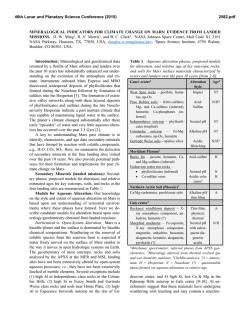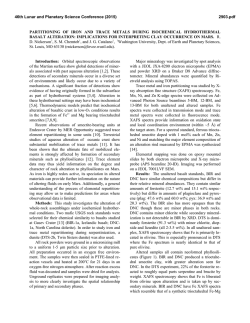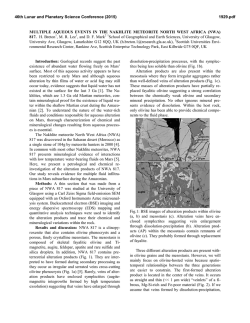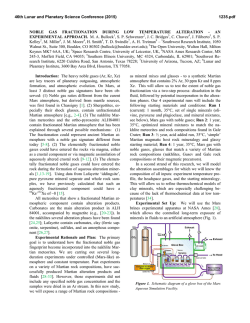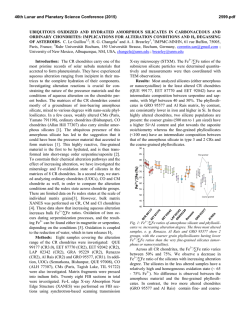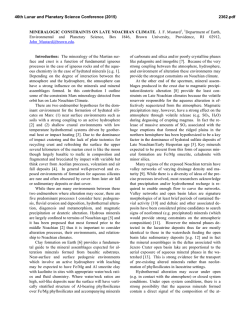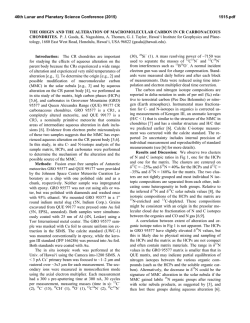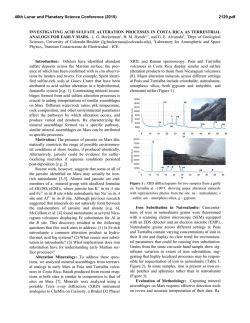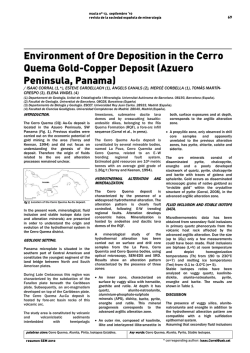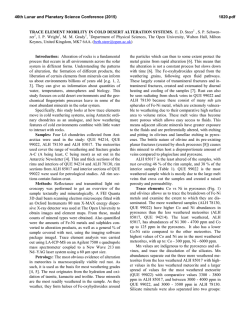
Microchemical Environments of Aqueous Alteration in CR Chondrites
46th Lunar and Planetary Science Conference (2015) 1470.pdf MICROCHEMICAL ENVIRONMENTS OF AQUEOUS ALTERATION IN CR CHONDRITES: CHEMICAL EQUILIBRIUM MODELS. M. Yu. Zolotov1, A. Morlok2, and G. Libourel3. 1School of Earth and Space Exploration, Arizona State University, Tempe, Arizona 85287-1404, e-mail: [email protected]; 2Wilhelm– Klemm-Strasse 10, 48149 Münster, Germany; 3Géoazur, UNS-CNRS, OCA, 250 rue Albert Einstein, 06560 Valbonne, France. Fig. 1. The equilibrium secondary mineralogy and aqueous chemistry that correspond to aqueous alteration of CR’s matrix and Fe-Ni metal end members and their mixtures. The model gives insights into chemical gradients at matrix-metal interfaces. 100 oC, 1.5 bar, W/R = 1 serpentine Volume (cm3/kg rock) magnetite saponite 100 chlorite pyrrhotite 10 Ni sulfide 1 calcite rhodonite Ni rich condensed metalKamacite massorganics fraction (pyrene) 0.1 0.0 1 0.2 0.4 0.6 Na 0.1 Mole/(kg H2O) chromite whitlockite CO3 OH 1.0 + P5+ ions 2- 0.8 K + Mn 2+ Mg 0.01 HCO3 0.001 Cl - 2+ - NaOH NaHSiO3 formate H2 NaCl HS- 0.0001 0.0 11 10 9 8 7 6 0.0 Fe 2+ 0.2 0.4 0.6 0.8 1.0 0.2 0.4 0.6 0.8 1.0 pH Introduction: The CR carbonaceous chondrites reveal signs of uneven aqueous alteration on parent bodies [1-4]. Some CR samples are among the least aqueously altered carbonaceous chondrites [4] while others show nearly complete alteration. The alteration occurred below ~300 oC and led to the formation of serpentine, saponite, magnetite, pyrrhotite, pentlandite, carbonates, and phosphates. The distinct alteration mineralogy of fine-grained matrix (serpentine, saponite, magnetite, pyrrhotite, pentlandite, and calcite), Fe-Ni metal (magnetite, Fe- and Fe-Ni sulfides, Ni rich metal, and phosphates), and chondrule silicate phases (e.g. chlorite) implies alteration in microchemical environments. Petrochemical studies of CR chondrites indicate fluid mixing and/or aqueous diffusion of species at the Fe-Ni metal-matrix and other interfaces (mesostasis-matrix, Fe-Ni metal-mesostasis) [5]. These data imply that S from matrix is supplied to alteration rims around Fe-Ni metal grains. The alteration of Fe-Ni metal grains delivers Fe, Ni, P, Cr, Ti, and Mn to the surroundings [5]. The chemical exchange of local fluids is reflected in the mineralogical zoning of rims around Fe-Ni metal grains [6]. Here, we have used equilibrium chemical thermodynamic methods to evaluate microenvironments (secondary mineralogy, solution chemistry and pH) during alteration of CR’s matrix and Fe-Ni metal, and developed initial models for the matrix-metal interface. Approach: The mineralogy and chemistry of aqueous alteration were evaluated through calculations of chemical equilibria in the rock-water-gas type system O-H-C-Cl-S-Mg-Ca-Si-Al-Na-K-Cr-Mn-Fe-Co-Ni-P. The unaltered rock was signified by the composition of CR’s Ni-Fe metal [5], water-free matrix [7], or their mixtures. Water was represented by either pure water or aqueous solution formed through alteration of the matrix. Equilibria were calculated for T = 0–300 oC and P < 100 bars above P of water-gas saturation, which is considered to be a minimal P during aqueous alteration. Formation of methane was suppressed because of low reaction rates at chosen T and P [8]. Water-soluble organic species were represented by one C species that may equilibrate: formate, methanol, and formaldehyde [8]. Condensed organic species were exemplified by pyrene (C16H10), which may not equilibrate with other species. Therefore, the models for the organic-inorganic equilibration were tentative. Calcula- Matrix Fe-Ni metal mass fraction Fe-Ni met. tions were performed with GEOCHEQ codes [9] which were previously applied for chondrites [e.g. 10]. Alteration progress (Ap) of a chosen rock was modeled by calculations of equilibria at a series of water/rock (W/R) mass ratios at a specified bulk W/R mass ratio, Ap = [bulk W/R]/[W/R]. The common presence of unaltered phases in CR chondrites indicates incomplete alteration at low bulk W/R ratios [3-5]. We used the bulk (accreted) W/R mass ratio of 0.1 to interpret runs at variable W/R ratios in terms of alteration progress. 46th Lunar and Planetary Science Conference (2015) Fig. 2. An exemplary mineralogy of aqueous alteration of Fe-Ni metal by matrix-equilibrated solution at a bulk W/R mass ratio of 0.1. Early stages of alteration correspond to larger masses of aqueous solution reacted with smaller masses of metal. An addition of even a small amount of Fe2+ from altering metal to the S-bearing fluid causes precipitation of low-solubility Fe and Ni sulfides observed in sulfide-magnetite alteration rims at matrix-metal interfaces. The solution fully consumes at Ap ≥ 0.2. 150 oC, 25 bars, bulk W/R = 0.1 Volume (cm3/kg rock) Matrix alteration: The computed secondary mineralogy mainly consists of serpentine and saponite and lesser amounts of chlorite, as can be seen at the lefthand side of Fig. 1. These phyllosilicates form in most of the modeled conditions. Pyrrhotite and NiS (a proxy for pentlandite) form in a wide range of Ts at mildly oxidizing conditions corresponding to early stages of alteration and/or fluid pressures < 20–50 bars above that of water-gas saturation. At higher Ts, these sulfides form at higher Ps. Troilite and Ni rich metal, which are not common in CR matrices, form at higher Ps and at advanced stages of alteration. Magnetite occasionally forms at earlier stages and lower Ps; it occurs in a wide range of Ps at higher Ts. Cronstedtite, which has not been reported in CR chondrites, forms at low Ts (< ~100 oC) and at Ps of water saturation. Minor phases are calcite, whitlockite, chromite, and organics. Alteration fluids are strongly alkaline (pH depends on T and P) and the most abundant solutes are Na+, Cl-, OH-, CO32-, HCO3-, K+, and H2. Low-T and early alteration fluids are Na-CO32-/HCO3- or NaOH type solutions while high-T and advanced alteration fluids are NaCl type fluids rich in H2. NaOH fluids form in carbonate-deficient reduced high-P systems [cf. 10]. Advanced alteration fluids coexist with H2 rich gas formed via oxidation of elements (Fe, P, Ni, Cr, etc.) by water. If the bulk W/R mass ratio in the matrix is below 0.16 ± 0.4, water solution completely converts to hydrated and/or oxidized phases, salts, and H2 rich gas. Partially altered matrices observed in some CR chondrites imply bulk W/R ratios below these values. Fe-Ni metal alteration: The computed alteration products of Fe-Ni metal (Figs. 1 and 2) are dominated by magnetite. Magnetite, Ca-phosphate (whitlockite), and chromite form in all of the considered conditions. Pyrrhotite, NiS, Ni rich metal, and FeS, mainly form at conditions described above for matrices. Schreibersite is stabilized at high-P conditions and/or at advanced H2-rich stages of alteration. Solutions are rich in Na+ and P5+-bearing ions (PO43-, HPO42-, and H2PO4-) and have a pH of 4 ± 0.5 units lower than in matrix fluids. The solutions are more abundant in Mn2+, Mg2+, and Fe2+ ions than matrix fluids. Metal oxidation by water forms abundant H2 that separates to the gas phase. The solution is fully consumed at a bulk W/R mass ratio of ~0.5 and a portion of metal remains unaltered at lower W/R ratios. Abundant H2 rich gas may divert the aqueous solution from metal grains and account for the patchy alteration of matrix. Alteration in CR chondrites seems to take place on a scale of only a few 100s of µm, which would confirm a localized, patched alteration [4-6]. Matrix-metal interfaces: The modeled alteration of matrix-metal mixtures demonstrates strong compositional and pH gradients which are reflected in the com- 1470.pdf Fe-Ni metal magnetite 100 pyrrhotite Ni sulfide 10 no Ni rich metal solution forms chromite shreiber. whitlockite 1 10-4 10-3 10-2 10-1 10 10 Alteration progress (= 0.1/[W/R]) position of alteration minerals (Fig. 1). The alteration of matrix-equilibrated fluids with Fe-Ni metal (Fig. 2) leads to formation of abundant Fe and Ni sulfides at elevated W/R ratios which could represent the early stages of metal alteration. These stages correspond to formation of the observed multilayer sulfides-magnetite mineralogy of outer alteration rims around metal grains in Al Rais CR2 and GRO 95577 CR1. Conclusions: The models show formation of chemically distinct solid-liquid-gas type environments through aqueous alteration of matrix and Fe-Ni metal. This diversity implies compositional, pH, and redox gradients at metal-matrix interfaces, diffusion of aqueous species, and precipitation of diverse minerals in local fluid mixing zones. These models reproduce observed local alteration mineralogies in a series of CR2 to CR1chondrites [4, 5]. Further comparison with CR’s chemistry and mineralogy will be presented in [6]. References: [1] Weisberg M. K. et al. (1993) Geochim. Cosm. Acta, 57, 1567–1586. [2] Krot A. N. et al. (2002) Meteorit. Planet. Sci., 37, 1451–1490. [3] Brearley A. J. (2006) In: Meteorites and the Early Solar System II, U. of Ariz. Press, Tucson, 587–624. [4] Abreu N., Brearley, A. (2010) Geochim. Cosm. Acta, 74, 1146–1171. [5] Morlok A., Libourel G. (2013) Geochim. Cosm. Acta, 103, 76–103. [6] Morlok A. et al. (2015) in prep. [7] Zolensky M. E. et al. (1993) Geochim. Cosm. Acta, 57, 3123–3148. [8] Seewald J. et al. (2006) Geochim. Cosm. Acta, 70, 446–460. [9] Mironenko M. V. et al. (2008) GEOCHEQ_M. In: Vestnik Otdelenia Nauk o Zemle RAN, 1(26). [10] Zolotov M. Yu. (2012) Icarus, 220, 713–729.
© Copyright 2025

